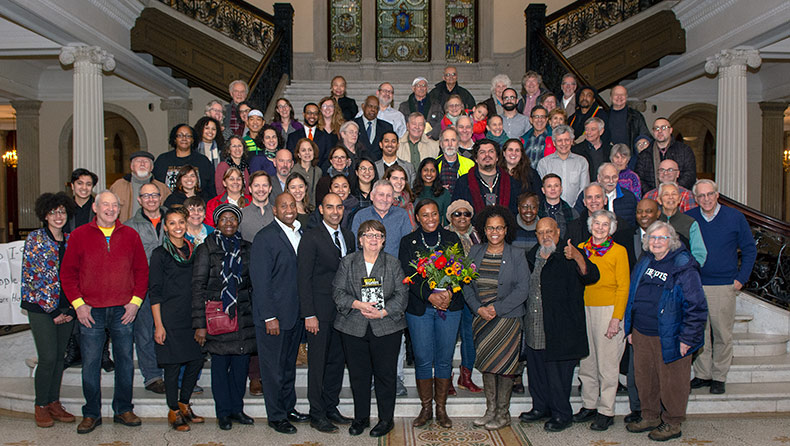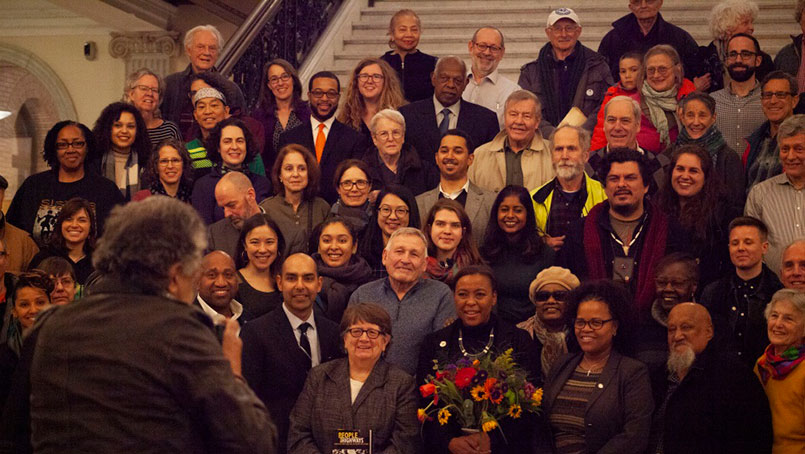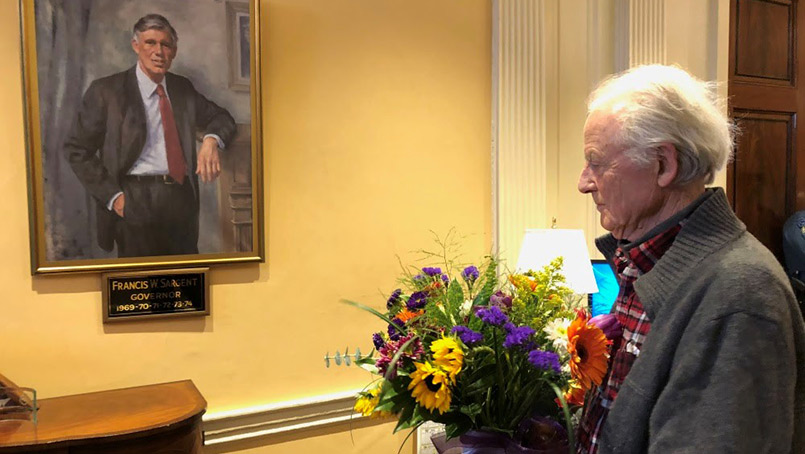
30 Jan 2019 People Before Highways Rally: 1969 + 50 at the State House
On January 25th 2019 MIT’s Karilyn Crockett, author of People before Highways, led a group of the original activists from across the region to the Massachusetts State House to commemorate the 50thanniversary of the pivotal 1969 fight to stop I-95 and the Inner Belt. Chris Lisinski captured the populist legacy of the anti-highway movement organizers in the following article for the State House News Service.
By Chris Lisinski
STATE HOUSE, BOSTON, JAN. 25, 2019…Fifty years to the day after thousands of protesters rallied at the State House to oppose a highway expansion that would have cut through the greater Boston area, veterans of that movement and other activists returned Friday to mark the anniversary.
An event marking the 50th anniversary of the 1969 protest against the Inner Belt highway system drew a crowd ranging from 78-year-old Chuck Turner (lower right), one of the original protest leaders, to freshmen state lawmakers.
An event marking the 50th anniversary of the 1969 protest against the Inner Belt highway system drew a crowd ranging from 78-year-old Chuck Turner (lower right), one of the original protest leaders, to freshmen state lawmakers.
Attendees gathered in front of the Grand Staircase for a ceremony honoring the 1969 protest, known as the “People Before Highways Day.” The protest and subsequent efforts successfully blocked the so-called Inner Belt and Interstate 95 construction projects that had been proposed as part of a sweeping federal highway update.
The idea for the ceremony, according to organizer and MIT lecturer Karilyn Crockett, who wrote a book on the 1960s movement, was to bring 50 people — one for each year that has passed — to the State House on the anniversary. That was quickly surpassed: about 150 people arrived, cheering and applauding throughout the event.
“After the Boston region came together to raise their voices in opposition to a plan they felt was wrong, was unjust and represented death and the end of their community, today we gather to celebrate them, to honor them and to make sure that work continues,” Crockett said. “We are not finished yet.”

An event marking the 50th anniversary of the 1969 protest against the Inner Belt highway system drew a crowd ranging from 78-year-old Chuck Turner (lower right), one of the original protest leaders, to freshmen state lawmakers. [Photo: Chris Lisinski/SHNS]
The proposed highway changes came as part of a post-Eisenhower attempt to modernize the country’s interstate system. The Inner Belt, conceptualized as a six-lane highway linking to Interstate 93, would have cut through Boston, Cambridge, Somerville and Lynn, dividing neighborhoods and putting thousands of homes at risk of major changes, according to advocates.
Organizers were successful, though, and in 1972, Gov. Francis Sargent — who had taken office just days before the 1969 protest at the State House — declared a massive alternative transportation plan, one that invested in public transit and other roadways.
“It was the first time outside the war on poverty that people from different neighborhoods came together, that activists stood up and said we have to struggle with others,” said Chuck Turner, one of the original organizers, during the Friday ceremony.
Jack Wofford, 83, former director of the Boston Transportation Planning Review committee, placed a floral arrangement in front of former Gov. Francis Sargent’s portrait at the State House.
A wide range of speakers participated Friday. Turner, now 78, was joined by other members of the 1969 protest. Rep. Russell Holmes, Rep. Nika Elugardo and Rep. Liz Malia, all of Boston, also spoke about the historical significance of the movement.
“Organizing isn’t just powerful to stop the highways,” Elugardo said. “Organizing protects affordable housing. Organizing wins elections. Organizing … demands that justice is for every single person.”

Jack Wofford, 83, former director of the Boston Transportation Planning Review committee, placed a floral arrangement in front of former Gov. Francis Sargent’s portrait at the State House. [Photo: Chris Lisinski/SHNS]
They placed the flowers in front of Sargent’s picture and paused. The move, Wofford said, was a “tribute to this great man.”
But those who went through the turmoil years ago stressed that the story does not end with the highways. Instead, they said, it is an example of how communities can work together to protect against forces of racism and gentrification and inequality.
“We are in a challenging time,” Turner said. “We know we’re in a city where there are forces that want to drive a lot of us out, drive those of us who don’t have much money out, drive out those of us who they don’t see as educated, drive out those who don’t fit their image of what a human being should be.”
“This is an even more difficult struggle than I think we were having in the ’60s,” he continued. “We have to do it again because we can’t afford to lose.”



